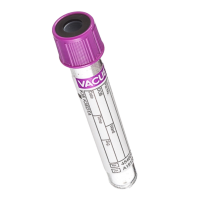
Test Code: 97758
CPT Code: 87536
Alternative Name(s): HIV-1 RNA QN RT-PCR
Methodology: Reverse Transcription Polymerase Chain Reaction
Clinical Significance: Human Immunodeficiency Virus (HIV) is the etiologic agent of Acquired Immunodeficiency Syndrome (AIDS). It can be transmitted through sexual contact, exposure to infected blood or blood products, or from an infected mother to the fetus. Acute HIV syndrome, characterized by flu-like symptoms, develops three to five weeks after initial infection and is associated with high levels of viremia. Within four to six weeks of the onset of symptoms, HIV specific immune response is detectable. After seroconversion, viral load in peripheral blood declines and most patients enter an asymptomatic phase that can last for years.
Quantitative measurement of HIV-1 RNA levels in plasma has been shown to be an essential parameter in prognosis and management of HIV-1 infected individuals. Viral load monitoring of HIV-1 levels is considered the most reliable indicator of initial and sustained response to anti-retroviral therapy (ART) and should be obtained at the entry into care, at initiation and during therapy.
Decisions regarding changes in antiretroviral therapy are guided by monitoring changes in plasma HIV-1 viral load levels over time. The minimal change in viral load considered to be reflective of a significant change associated with antiretroviral therapy within the first 2 to 8 weeks is equal to 0.5 Log Copies/mL reduction. In addition, optimal viral suppression is considered when the viral load remains persistently below the lower limit of detection.
Virological response failure, which is suggestive of resistance to current antiretroviral therapies, is considered to occur when there is a persistently elevated HIV-1 viral load according to guidelines. If resistance is confirmed, the ART is revised to use higher-tiered drugs. HIV-1 RNA levels in plasma can be quantitated by nucleic acid amplification.
The HIV-1 assay will be used to measure the levels of HIV-1 RNA isolated from patient plasma and to determine changes in viral load, which, in conjunction with clinical presentation and other laboratory markers, is indicative of the effectiveness of antiviral therapy.
The RNA genome of HIV-1 exhibits a high degree of genetic variability.24 High-frequency occurrence of natural polymorphisms within primer/probe binding sites can result in inefficient hybridization and lead to underquantitation or lack of detection for a nucleic acid test method based on the PCR technology. Therefore, to ensure assay robustness, the Alinity m HIV-1 assay is designed to target two highly conserved sequences within the HIV-1 genome.
In addition to the HIV-1 primer/probe sets, the Alinity m HIV-1 assay utilizes an internal control (IC) primer/probe set for amplification and detection of an IC target sequence, which is not related to HIV-1. The IC probe is labeled with a different fluorophore than the HIV-1 probes. This allows for simultaneous detection and discrimination of both the HIV-1 and IC amplified products within the same reaction vessel.
Supply: #T59 - Lavender 4mL Blood Tube
Preferred Specimen: Plasma
Preferred Volume: 2mL
Collection Instructions: Mix by gentle inversion 3-4 times. Centrifuge to separate plasma from cells. Remove plasma immediately and refrigerate.
Transport Container: Pour off tube
Transport Temperature: Refrigerated
Specimen Stability: Refrigerated: 3 days
Reject Criteria:
Specimens exceeding stability, specimens collected in collection devices/tubes other than EDTA
For additional test, supply, or collection device information, please contact DLO's Customer Service at (800) 891-2917, option 2.
The CPT codes provided are based on AMA guidelines and are for informational purposes only. CPT coding is the sole responsibility of the billing party. Please direct any questions regarding coding to the payor being billed.
